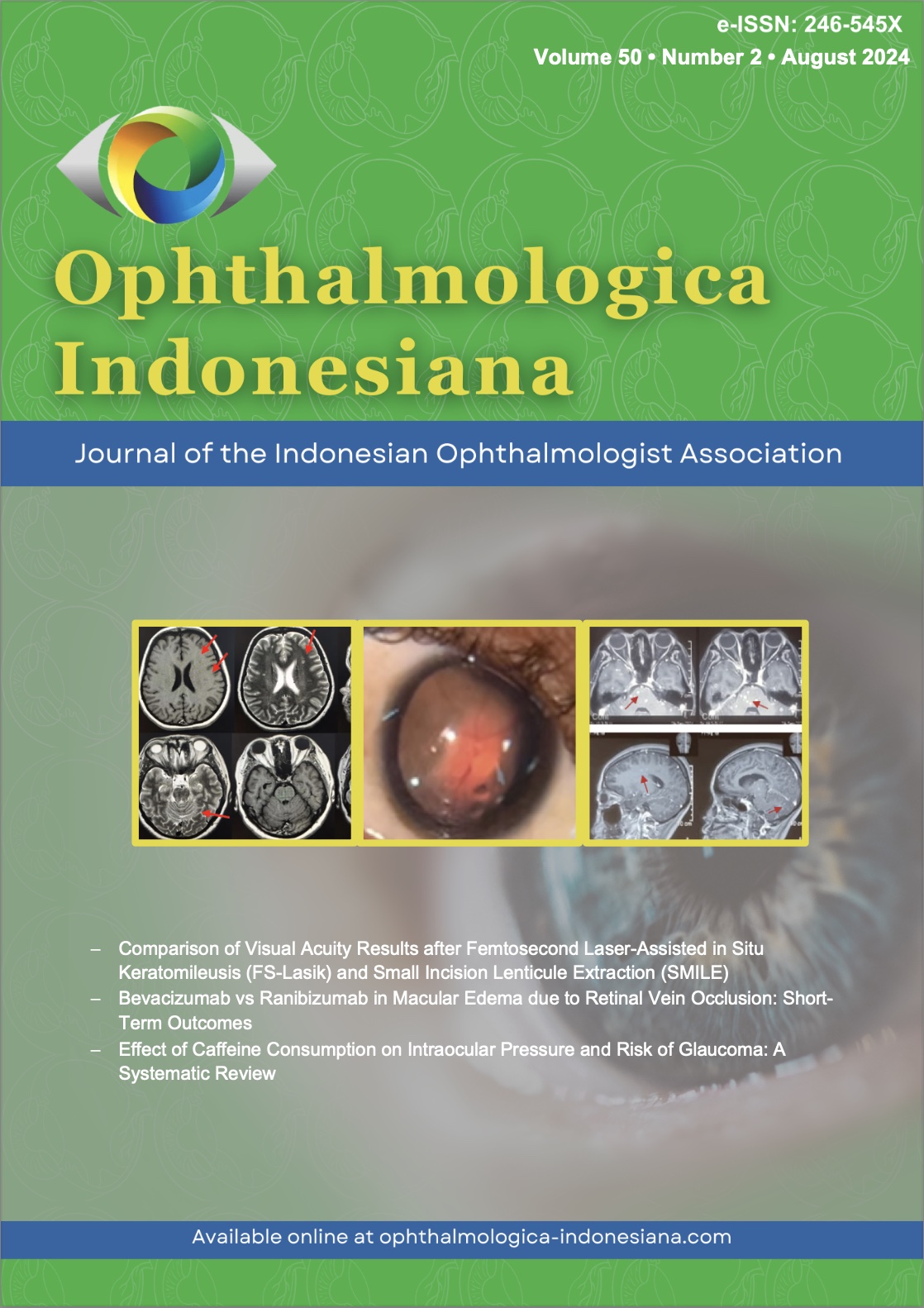Insights into Primary Open-Angle Glaucoma Patients: Unveiling Demographic, Clinical, and Therapeutic Profiles in a Leading Tertiary Referral Hospital in Yogyakarta
Abstract
Introduction: Primary open-angle glaucoma (POAG) is the primary cause of irreversible blindness in adults worldwide. The characteristics of glaucoma patients and their response to therapy may differ by institution, region, and country. This study aimed to describe the demographic, clinical, and therapeutic aspects of POAG patients at Dr. Sardjito General Hospital Yogyakarta.
Methods: This study included POAG patients who underwent full clinical ophthalmologic evaluations at Dr. Sardjito General Hospital Yogyakarta from January to December 2021. Characteristics such as age at presentation, sex, residence, visual acuity, intraocular pressure (IOP), cup-to-disc ratio (CDR), laterality of affected eyes, Humphrey field analyzer-measured mean deviation (MD), and pattern standard deviation (PSD), medical and surgical treatment were recorded retrospectively.
Results: Data from 253 POAG patients were collected, the mean age was 52±17.15 years old and the female sex was more common at 58%. The mean IOP was 16.49±8.02 mmHg, and the mean CDR was 0.68±0.18. The mean refractive errors of all eyes were -0.64±0.22 dioptres (D), with 63% of eyes had good visual acuity (6/12 or better), 19% had moderate visual acuity (6/15 to 6/50), and 18% had poor visual acuity (count fingers to no light perception). Furthermore, the mean MD and PSD were -8.89±12.01 dB and 4.73±3.52 dB, respectively. Of all patients, 81% received medication only while 19% received medication and surgical intervention. Trabeculectomy was the most common surgery performed (94%).
Conclusion: POAG is generally a bilateral disease and occurs mostly in middle age population. Overall, trabeculectomy was the most common surgery performed in POAG patients.
Full text article
References
World Health Organization. World report on vision. World Health Organization. 2019. Available from: https://apps.who.int/iris/handle/10665/328717.?
Allison K, Pasquale LR, Hark L, Saeedi O, Cho M, Rhee DJ. Epidemiology of Glaucoma: The Past, Present, and Predictions for the Future. Cureus. 2020 Nov;12(11):e11686. doi: 10.7759/cureus.11686.?
Albini TA, Berrocal AM. Basic And Clinical Science Course 2020-2021. San Francisco: American Academy of Ophthalmology; 2020. Section 10.?
Tham YC, Li X, Wong TY, Quigley HA, Aung T, Cheng CY. Global Prevalence of Glaucoma and Projections of Glaucoma Burden through 2040: A Systematic Review and Meta-Analysis. Ophthalmology. 2014 Dec;121(12):2081-2090.?
Zhang N, Wang J, Li Y, et al. Prevalence of primary open angle glaucoma in the last 20 years: a meta-analysis and systematic review. Sci Rep. 2021 Jun 30;11(1):13762. doi: 10.1038/s41598-021-92971-w.?
Yokoyama Y, Maruyama K, Konno H, et al. Characteristics of patients with primary open angle glaucoma and normal tension glaucoma at a university hospital: a cross-sectional retrospective study. BMC Res Notes. 2015 Jul 18;8:360. doi: 10.1186/s13104-015-1339-x.?
Stamper RL, Lieberman MF, Drake MV. Primary Open Angle Glaucoma. In: Stamper RL, Lieberman MF, Drake MV, editors. Becker-Shaffer's Diagnosis and Therapy of the Glaucomas. 8th ed. Edinburgh: Mosby; 2009. p. 239-265.?
Kreft D, Doblhammer G, Guthoff RF, Frech S. Prevalence, incidence, and risk factors of primary open-angle glaucoma - a cohort study based on longitudinal data from a German public health insurance. BMC public health. 2019;19(1):851. DOI: 10.1186/s12889-019-6935-6.?
Shekhar J, Ranjan K, Ranjana K, Verma NP. Glaucoma Pattern in Central Bihar–A Cross-Sectional Retrospective Study. Ophthalmology. 2010:7, 300-2.?
Thomas R, Parikh RS. How to assess a patient for glaucoma. Comm Eye Health J. 2006;19:36-37.?
Shakya-Vaidya S, Student P, Umesh R, Am G, Grjibovski A. Visual Status in Primary Open Angle Glaucoma: A Hospital Based Report from Nepal. J Kathmandu Med Coll. 2014;3.?
Heo DW, Kim KN, Lee MW, Lee SB, Kim CS. Properties of pattern standard deviation in open-angle glaucoma patients with hemi-optic neuropathy and bi-optic neuropathy. PLoS One. 2017 Mar 1;12(3):e0171960.?
Garg A, Gazzard G. Treatment choices for newly diagnosed primary open angle and ocular hypertension patients. Eye (Lond). 2020 Jan;34(1):60-71.?
Owen CG, Carey IM, De Wilde S, Whincup PH, Wormald R, Cook DG. The epidemiology of medical treatment for glaucoma and ocular hypertension in the United Kingdom: 1994 to 2003. Br J Ophthalmol. 2006 Jul;90(7):861-8.?
Tsai JC. Medication adherence in glaucoma: approaches for optimizing patient compliance. Curr Opin Ophthalmol. 2006 Apr;17(2):190-5.?
Weinreb RN, Aung T, Medeiros FA. The pathophysiology and treatment of glaucoma: a review. JAMA. 2014 May 14;311(18):1901-11.?
Authors
Copyright (c) 2024 Lailatul Rizkah

This work is licensed under a Creative Commons Attribution-NonCommercial-ShareAlike 4.0 International License.

